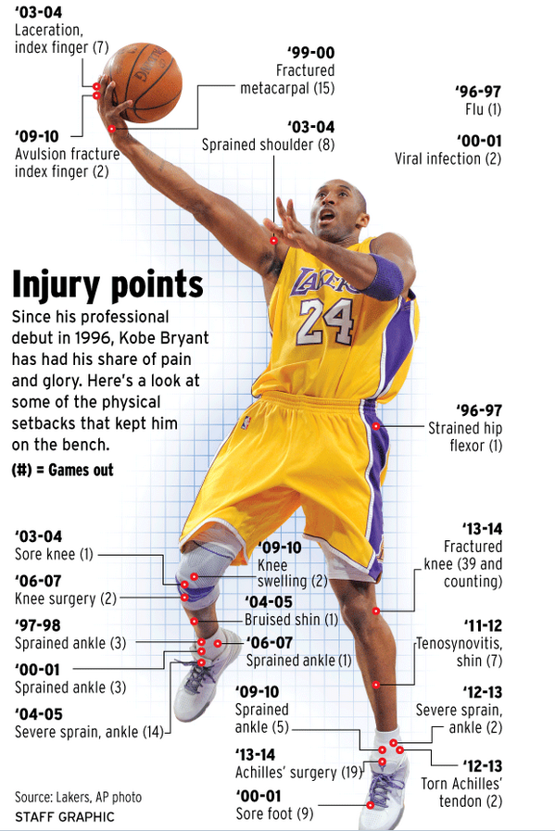by Dr. Troy Vander Molen, PT, DPT
Like most of you, I reeled when I heard the tragic news about Kobe Bryant, his daughter Gianna, and the seven others who lost their lives in a helicopter crash last Sunday. His talent is what initially attracted most to Kobe, but his personality & mamba mentality made a lasting impression.
While there have been many world-class athletes over the years, it seems to me that none made as seamless a transition to life as a retired athlete than Bryant. Though he was not a perfect man – who is? – in the aftermath of his life, we are hearing again and learning more about his priorities, his convictions, and his focus, all things he had taken from his most competitive basketball experiences and applied to all facets of his life.
When I reflect on his life, I remember reading stories about his experiences, success, and commitment to the professionals that helped him recover from his injuries so that he could continue to compete at the highest level. He was no stranger to the training room, as evidenced by this infographic from @bill_oram:

A two-part series of articles was published on NBA.com in 2012, which featured an interview with Kobe Bryant’s physical therapist, Dr. Judy Seto (part one: https://www.nba.com/lakers/features/secretweapon, part two: https://www.nba.com/lakers/features/secretweaponpart2) who worked with the Lakers for over 20 years and was referred to as Kobe’s “secret weapon.” She and Gary Vitti, an athletic trainer, worked with Kobe Bryant to restore his health throughout his entire illustrious NBA career.
The Mamba Mentality
What Dr. Seto shared about Kobe’s mamba mentality could help you be successful in physical therapy just like Kobe. Borrowed from excerpts of that article series, here are my keys to rehab success according to Kobe:
- Work on getting in great physical shape now, which will reduce the likelihood that you’ll need physical therapy and help you recover faster if you do in fact need physical therapy. Dr. Seto said that “because [Kobe is] in such good health and how much he works on his body, his recovery is indeed faster.” And he worked on his health “both physically and mentally.”
- Be intelligent and seek understanding about how your body works, and find a physical therapist that works on restoring whole-body function, not just eliminating pain. Dr. Seto emphasized that Kobe “really wants to know the information about what’s going on with his body. Over the years he’s developed a keen understanding of his body, so when we discuss injuries he picks things up very quickly… He knows the relationships of how a certain injury impacts another body part… He gets the relationship between the core and one’s lower body strength. That entire area impacts the knee.”
- Make your physical therapist work to earn your trust. Dr. Seto admitted that Kobe was particular. You should be too. “You only have one shot with [Kobe]… If there was a lack of trust not only with him and other players, the team doctors and so on, that would have been it.” And she added, “The best way to earn his trust is to know what you’re talking about. He’s seeing me for a reason: how can I help him be a better basketball player. If I couldn’t help him, he woudn’t [have] come back.”
- Have a positive attitude about your physical therapy experience. “How you approach an injury really impacts the actual healing process and how well people come back from their injury. It can take a guy with a great attitude a shorter period of time to get better than it might someone with a negative attitude; those things really matter,” said Dr. Leto. “Focusing on the future can be really important, and takes so much less energy from someone that has a negative thought process.”
- Commit to doing what you need to do to get better. Dr. Seto called Kobe “the consummate professional. He wants to do whatever it takes to get better… [and he] wants treatments that are rooted in science.”
- Recognize that pain is often a part of the process. “He also has the highest pain tolerance of anybody I’ve ever met,” said Dr. Seto. “It’s not that he doesn’t feel pain, but that he does not let it take over his mind set. He can block out a lot of things to not allow the pain to interfere or limit him… He won’t put himself in jeopardy by ignoring pain and making unwise decisions. But because he understands his own body well, he can live with pain and still play at a very high level.”
- Seek physical therapy early and often. One of the biggest benefits of being in the NBA is that Dr. Seto gets to “see the players every day, and they [get] to see me too, so if anything happened, we could address it right away. Dr. Seto added that she can “address things sooner and keep problems at a very minor level instead of having an early injury grow and impact other areas of the body.”
- Communicate well with your physical therapist. In the Lakers’ organization, the players and health care team “[work] well together, and with lines of communication open we can often nip things in the bud before they become an issue.”
Apply the Mentality
While the world continues to mourn the loss of Kobe Bryant, I’m gratified that the unique “Mamba Mentality” he adopted will continue to live on and positively impact others for generations. If you want to apply the Mamba Mentality to your own physical health issues, contact Kinetic Edge to visit with one of our physical therapists. Request a free injury screen today or call us at 866-588-0230!



